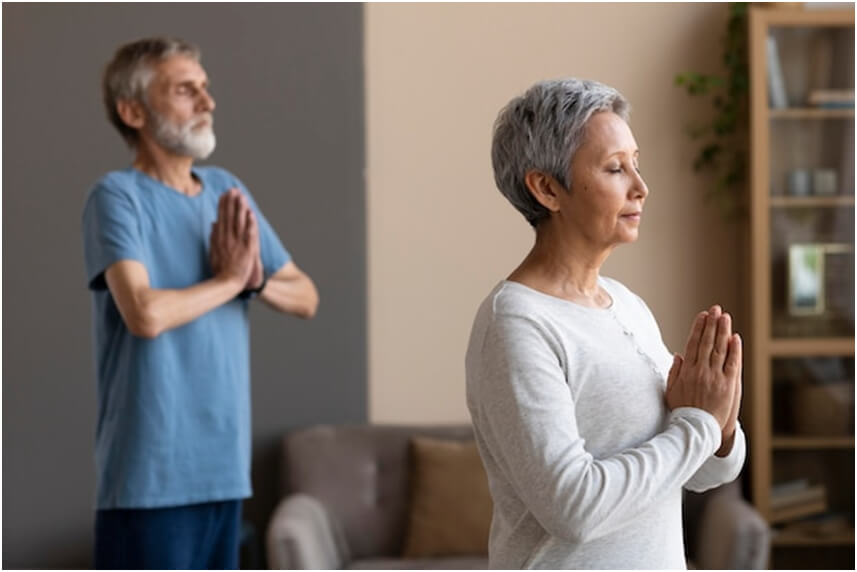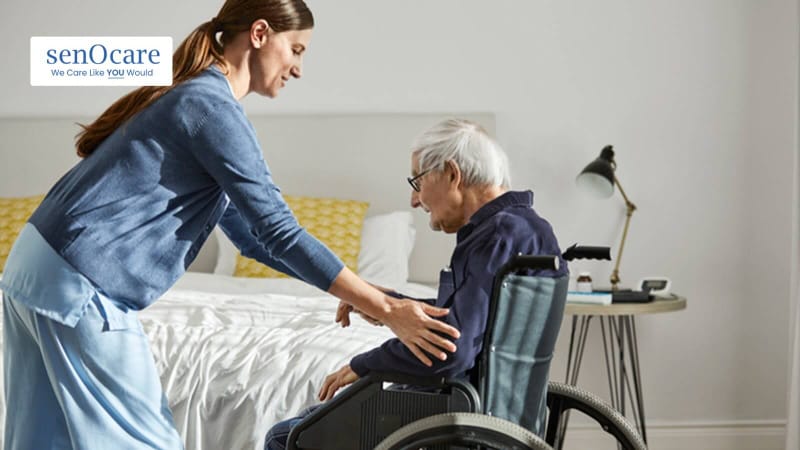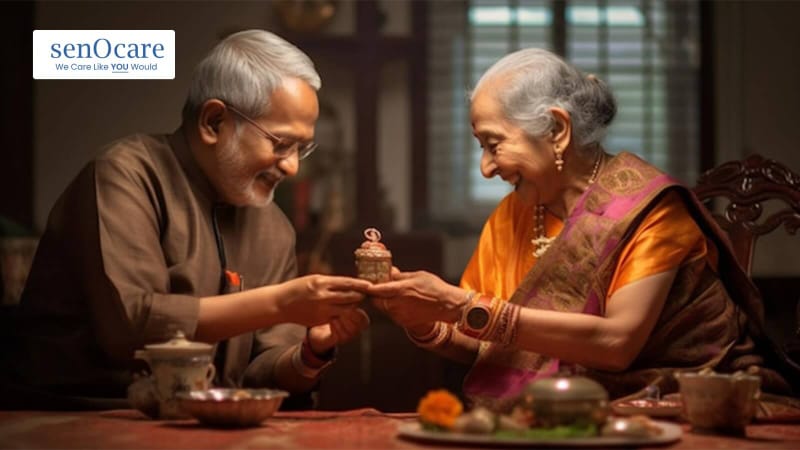Physical activity is essential at every stage of life, but it is the pillar of elder care and wellness. Many of the health concerns that come with aging can be alleviated by exercise-based interventions. Research indicates that 150–300 minutes a week of moderate workouts can improve a senior’s quality of life and health. Incorporating regular exercise and healthy eating habits ensures a safe journey through the advanced years of life.

What are the benefits of exercise for older adults?
Studies and research in elder care say that regular exercise can positively impact the physical health and mental well-being of the elderly. Even older adults with medical conditions such as arthritis, heart disease, obesity, and high blood pressure can gain from routine moderate exercise. Some of the key advantages are as follows:
- Reduces the risk of chronic diseases ‒ cardiovascular disease, diabetes, obesity, and high blood pressure
- Prevents bone loss and improves bone density
- Reduces the risk of falling or fracturing bones
- Helps lessen the pain from arthritis, joint pain, and stiffness
- Improves cognitive wellness and functions by easing stress and depression symptoms
- Increases self-confidence by making physically active and fit
- Increases independence, sociability, and happiness
Physical health benefits of exercise for seniors
150-300 minutes a week of moderate physical activities like walking, stretching, and breathing exercises can improve quality of life and increase life expectancy. These activities are generally safe for most elderly and have numerous health benefits:
- Reduces pain and quality of life for those with arthritis, joint, and nerve pain
- Prevents bone loss and osteoporosis
- Builds muscle mass and helps increase metabolism to control weight
- Reduces the risk of developing type 2 diabetes, cardiovascular disease, and stroke
- Helps control blood sugar, and cholesterol levels and lowers the risk of heart disease and nerve damage for people with type 2 diabetes
- Decreases the risk of falls or injury from a fall
- Helps support daily living activities with increased independence
Mental health benefits
Regular physical activity produces endorphins (the “feel-good” hormone), which help in easing stress and depression symptoms, thereby leaving one happy and satisfied. In addition, exercise in elder care and wellness has been linked to the improved cognitive ability of
thinking, learning, memory function, and judgment skills. Relaxation and breathing techniques have also benefitted many elderly who often suffer from insomnia and disrupted sleep patterns.
What if you hate to exercise?
All said and done about the proven benefits of physical activity in senior care, starting a regular exercise regime can be overwhelming as one gets older. Physical exercise, at any stage, can make a big difference in one’s life than one can ever imagine. And it’s never too late to start. As it is said, “A journey of a thousand miles begins with a single step.” Try incorporating these into your exercise routine:
- Take small steps, one at a time. Start with a shorter duration and gradually increase it to 30 minutes a day
- Keep your initial workout regime flexible by including walking, stretching, or simple balancing exercises
- Connect with a personal trainer
- Turn on some music while exercising
- Stretch a bit, go for a run or walk when you’re feeling stressed
- Watch self-improvement motivational shows on television and the internet
- Socialise with your fitness buddies
Building a balanced exercise plan
Experts in this domain of elder care can suggest specific workouts and encourage them to indulge in moderate exercises‒walking, stretching, Yoga, etc. Universal guidelines for developing a balanced workout regime include low-to moderate-level activity every other day, starting with walking, flexibility exercises, to a range of balance motion exercises. These are some tips that may come in handy.
- Walking is one of the easiest cardio activities to start with that helps in burning calories
- Yoga and meditation uses the mind-body-soul approach to increase flexibility and reduce stress
- Aerobic exercises like jogging, leg-lift, swimming, dancing, gardening are excellent to maintain mobility and reduce risk of falls
- Balancing activities like walking heel-to-toe, squatting, Tai Chi, etc. can help build muscle strength and improve posture, stability
Tips for staying motivated
The result is always rewarding, albeit the process is gradual. As we grow older, this will pay higher dividends. While it may seem like a lot of effort to develop new habits, physical
activities are no less than "vitamins of active aging" in senior care. Here are some tips to stay motivated and incorporate physical activity into daily life.
- Create an exercise schedule; including various types, frequency, and intensity
- Set realistic goals, check progress, follow up to re-evaluate goals
- Make it easy, fun, and engaging by including music, videos, and TV shows
- Hire a trusted senior care service provider who can motivate to regularly exercise and be on hand in case of any support
- Help achieve peak performance by keeping hydrated
The aging process is not unique and hits different people differently. While moderate exercises are safe for most elderly, consult a physiotherapist before starting your routine workout. Make safety the topmost priority during your workout session. Look out for any unnatural discomfort, pain, or dizziness while exercising. It could be a warning sign to stop immediately and report to your physician.
Senocare is a trusted name in personalized senior care service. Our Care Managers are available 24x7 to take care of their physical, emotional, and mental health and wellness everyday. For more information about our holistic elder care solutions, call us today at +91 8800 003 046 or email us at info@senocare.in.
FAQs
-
What Happens to Muscles As We Age?
Loss of muscle mass and strength, called sarcopenia, is a natural part of aging. It starts from the age of 30 and tends to increase after 60.
-
Is It Ever Too Late to Build Muscle?
As you grow older, muscles lose their strength and flexibility. Staying physically active strengthens muscles and delays loss.
-
Can I Get Stronger Without Building Big Muscles?
Research in senior care indicates that regular resistance training and other exercises help strengthen bones, muscles, and counteracts age-related weakness and frailty.
-
What Happens to Flexibility As We Age?
Decline in flexibility is a normal part of aging. It happens because muscles and joints get stiffer, making it harder to perform activities that require flexibility, such as climbing stairs.
-
What Happens to Balance As We Age?
Aging and inactivity in old age causes the brain processing to slow down, which results in slower balance responses. Falls are more likely to occur due to loss of balance.
-
What Happens to Bones As We Age?
With aging, bones lose their mass or density because of reduced calcium and mineral content. It is more common among women after menopause. Weak bones raise the risk of osteoporosis.
-
What Happens to Our Joints As We Age?
Joints become stiffer, and flexibility decreases as we age due to the changes in tendons and ligaments.
-
Does Exercise Help Cognitive Function?
Research says that regular physical exercise can improve cognitive ability of thinking, learning, memory, and judgment skills among the elderly.
-
Can Exercise Improve Mood?
Exercises, in any form are great stress-busters. It can knock out depression, negative mood and helps in improving self-esteem.
-
How much exercise Do I Need to Do for Health and Fitness?
According to W.H.O. guidelines, 150-300 minutes a week of moderate exercise regular can lead to better quality of life.
-
How Do I Get Started?
Take small steps, one at a time, and follow the same ritual initially. Start with a shorter duration for about 10-15 minutes a day and gradually increase it to 30 minutes a day as you get stronger. Enjoy while exercising, and you will soon start reaping the most benefits.
Disclaimer: This blog is for educational purposes only, and it shouldn't be treated as a medical advice.


